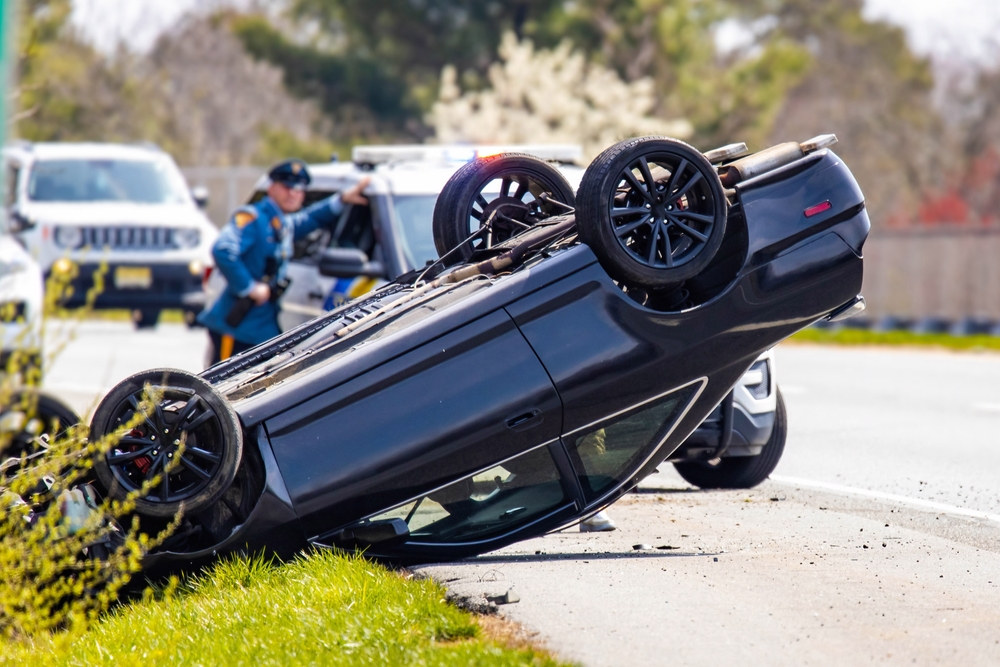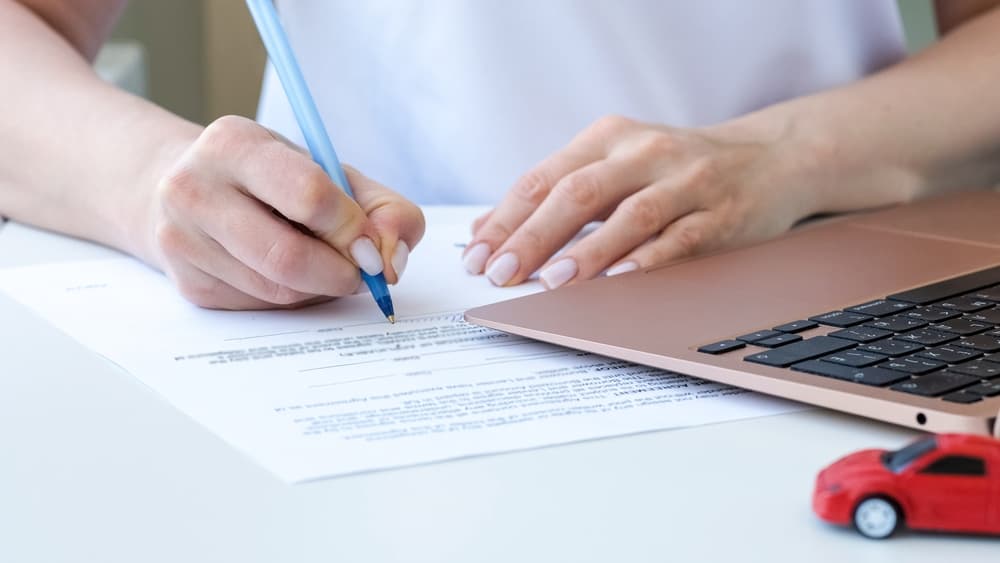Rollover accidents involving large trucks are among the most violent and devastating crashes on Minnesota roads. The sheer size and weight of commercial vehicles make these incidents especially dangerous, often causing traumatic brain injuries, spinal cord damage, broken bones, and other life-altering harm. Even with modern safety features, the force of a rollover can leave victims facing a long and difficult recovery.
If you or a loved one were hurt in a rollover crash, a skilled car accident lawyer can help you pursue the compensation you need for your medical expenses, lost income, and emotional suffering while you focus on healing.
Key Takeaways for What Types of Injuries are Common in a Rollover Accident
- Rollover accidents frequently cause catastrophic injuries like traumatic brain injuries (TBIs) and spinal cord damage due to violent, multi-impact forces.
- The design of a vehicle, particularly those with a higher center of gravity like SUVs and trucks, can increase the likelihood of a rollover crash.
- Common injuries also include severe bone fractures, crushing injuries from vehicle compression, and deep cuts from shattered glass and metal.
- Beyond physical harm, survivors of rollover crashes often experience significant psychological trauma, including PTSD and anxiety.
- In Minnesota, accident victims have a specific time frame, known as the statute of limitations, to pursue a legal claim for their injuries.
Why Are Rollover Accidents So Dangerous?

A rollover crash, one of the many types of motor vehicle accidents, isn't a single impact; it's a series of violent, unpredictable collisions. When a vehicle flips, its occupants are subjected to intense forces from every direction. The roof can collapse, windows can shatter, and unbelted passengers can be ejected, which is a leading cause of fatalities in these types of accidents.
Several factors can contribute to a rollover, and they often happen on roads we travel every day, whether it’s a busy highway like I-94 or a rural road out past Lake Minnetonka.
- High Center of Gravity: Vehicles like SUVs, pickup trucks, and vans are taller and narrower than sedans, making them more top-heavy and susceptible to tipping over, especially during a sharp turn or when "tripped" by a curb or soft shoulder.
- Speed: High speeds significantly increase the chances of a driver losing control. A sudden swerve to avoid an obstacle on the road can easily initiate a rollover when traveling at highway speeds.
- Multi-Vehicle Collisions: Being struck by another vehicle, particularly a large commercial truck, can provide enough force to flip a smaller car or SUV onto its side or roof.
These elements combine to create a uniquely hazardous event where the vehicle’s structural integrity is put to the ultimate test, and the human body is pushed past its limits.
The Most Severe Injuries Common in Rollover Accidents
The violent tumbling motion of a rollover is what makes the resulting injuries so severe. As the car flips, a person's body can strike the interior of the vehicle repeatedly, leading to devastating consequences.
Traumatic Brain Injuries (TBI)
A Traumatic Brain Injury, or TBI, happens when a sudden jolt or blow to the head disrupts the brain's normal function. In a rollover, a person’s head can easily strike the roof, door frame, or windows multiple times. This can cause the brain to collide with the inside of the skull, leading to bruising, swelling, and bleeding.
Even a "mild" TBI, like a concussion, is a serious medical issue. More severe TBIs can have lifelong effects. Symptoms can appear immediately or develop over days and weeks.
- Persistent headaches or neck pain
- Confusion, memory problems, or difficulty concentrating
- Changes in mood, such as increased irritability or depression
- Sensitivity to light and sound
- Loss of consciousness or seizures
These injuries often require extensive medical treatment, rehabilitation, and can permanently alter a person's ability to work, interact with family, and enjoy life.
Spinal Cord Injuries
The spinal cord is the bundle of nerves that carries messages between your brain and the rest of your body. When the vertebrae—the bones protecting the spinal cord—are fractured or dislocated in a rollover, the cord itself can be bruised, crushed, or severed.
Spinal cord injuries are catastrophic because they can lead to permanent paralysis. The location of the injury on the spine determines how much of the body is affected.
- Paraplegia: This is paralysis that affects all or part of the trunk, legs, and pelvic organs.
- Quadriplegia (or Tetraplegia): This is paralysis of the hands, arms, trunk, legs, and pelvic organs.
Even an incomplete spinal cord injury can result in chronic pain, loss of sensation, and loss of bladder or bowel control. The medical costs and need for lifelong care associated with these injuries are astronomical.
Broken Bones and Crushing Injuries
The sheer force of a vehicle rolling and its roof caving in can easily cause severe fractures. Arms, legs, ribs, and the pelvis are particularly vulnerable. These are not simple breaks; they are often compound fractures, where the bone breaks through the skin, or comminuted fractures, where the bone shatters into multiple pieces.
Crush injuries are another serious risk. This happens when a part of the body is pinned by a heavy object, like a collapsed roof or a dashboard. This can lead to:
- Severe damage to muscles and tissues
- Internal bleeding and organ damage
- Compartment syndrome, a dangerous condition where swelling cuts off blood flow
These injuries require emergency surgery, often involving plates, screws, and rods to set the bones. Recovery is long, painful, and may result in a permanent loss of mobility.
Other Significant Injuries You Might Face
While TBIs and spinal cord damage are among the most catastrophic outcomes, rollovers can cause a wide range of other serious injuries that can have a lasting impact on your health and well-being.
Deep Lacerations and Abrasions
When a car rolls, glass from the windshield and windows shatters and flies through the cabin. Torn metal from the vehicle's frame can also become exposed. This can cause deep cuts (lacerations) and severe scrapes (abrasions) all over the body.
These injuries often require stitches or staples to close and can lead to significant scarring and disfigurement. There is also a high risk of infection if the wounds are not properly cleaned and treated by medical professionals.
Soft Tissue Injuries
Soft tissue injuries refer to damage done to the body's connective tissue, like muscles, ligaments, and tendons. They may not be visible on an X-ray, but they can cause debilitating pain and limit your movement.
- Whiplash: This is a common neck injury caused by the head being violently thrown backward and then forward. It damages the muscles and ligaments in the neck and can lead to chronic pain and stiffness.
- Torn Ligaments and Tendons: The violent forces in a rollover can tear the connective tissues in joints like the knees, shoulders, and wrists, often requiring surgery to repair.
- Severe Bruising: Deep muscle contusions can cause significant pain, swelling, and limit the use of the affected limb for weeks.
It's a mistake to dismiss these as minor injuries, as they can lead to long-term pain and mobility issues if not properly addressed.
Psychological and Emotional Trauma
The impact of a rollover accident goes far beyond physical injuries. Surviving such a terrifying event can leave deep emotional scars that are just as real and debilitating as any broken bone.
Many survivors develop Post-Traumatic Stress Disorder (PTSD), a condition that can cause flashbacks, nightmares, and severe anxiety. It's also common to experience depression, a new fear of driving, or anxiety when riding in a car. This psychological trauma is a valid and significant part of your injuries, and seeking support from a mental health professional is a critical part of the healing process.
Understanding Your Rights After a Rollover Accident in Minnesota

When you're recovering from a rollover accident, the last thing you want to think about is legal paperwork. However, understanding your rights after a car accident is essential for protecting your future. If the accident was caused by another party's actions, you may be able to hold them accountable.
This often involves the legal concept of negligence. In simple terms, negligence means someone failed to act with reasonable care, and their carelessness caused the accident and your injuries.
- A driver who was texting and drifted off the road, causing their vehicle to roll.
- A reckless driver who was speeding and weaving through traffic, sideswiping your car, and initiating a rollover.
- A trucking company that failed to properly maintain its vehicle, leading to a tire blowout that caused a crash.
It's important to remember that in Minnesota, there is a deadline for taking legal action. This is called the statute of limitations. For most personal injury claims, including those from car accidents, the law gives you six years from the date of the injury to file a lawsuit. While that may seem like a long time, building a strong case takes time, so it's wise not to wait.
Steps to Take After You're Home and Healing
Taking a few organized steps in the days and weeks after your accident can help protect your well-being and any potential claim.
- Follow Every Medical Instruction: Your top priority is your health. Attend all follow-up appointments, go to your physical therapy sessions, and take all prescribed medications. This not only helps your recovery but also creates a clear medical record of your injuries.
- Keep a Recovery Journal: Write down how you feel each day. Note your pain levels, any physical limitations, and how your injuries are affecting your ability to do daily tasks, from getting dressed to enjoying hobbies. This journal can be a powerful tool for showing the true impact of the accident.
- Organize Your Paperwork: Keep all documents related to the accident in one place. This includes the police report, medical bills, receipts for prescriptions, and any letters from insurance companies.
- Be Careful with Insurance Companies: Remember that the other driver's insurance adjuster is not on your side. Their goal is to settle the claim for as little as possible, and that's why they usually offer a low, first settlement offer. It is often advisable to consult with a legal professional before giving a recorded statement or accepting any settlement offer.
Taking these steps can help bring a sense of order to a chaotic time and ensure you are in the best position to move forward.
FAQs: Common Injuries After Rollover Accidents
Can a rollover accident happen at low speeds?
Yes. While high speeds increase the risk, rollovers can happen at lower speeds. This often occurs when a vehicle is "tripped" by an object like a curb, a pothole, or a soft patch of dirt on the shoulder of the road. The vehicle's momentum, even at a lower speed, can be enough to cause it to tip over.
Are newer cars safer in rollovers?
Generally, yes. Modern vehicles have made significant safety advancements. Features like Electronic Stability Control (ESC) help prevent a driver from losing control in the first place. Stronger roofs, side curtain airbags, and advanced seatbelt systems also provide better protection for occupants if a rollover does occur. However, no car is completely rollover-proof, and serious injuries are still very possible.
What is "roof crush" and why does it matter?
Roof crush refers to the vehicle's roof collapsing inward during a rollover. This is extremely dangerous because it reduces the amount of survival space inside the cabin. A collapsed roof can directly cause catastrophic head and spinal cord injuries. Federal standards require vehicle roofs to withstand a certain amount of force, but in a severe rollover, that standard can be exceeded.
Can I seek compensation if I was a passenger in a rollover?
Yes. As a passenger, you have the same rights as a driver to seek compensation for your injuries. The claim would typically be made against the insurance policy of the at-fault driver, who could be the driver of the car you were in or the driver of another vehicle that caused the crash.
How does Minnesota's no-fault insurance work with a serious rollover injury claim?
Minnesota is a no-fault state, which means your own car insurance policy (specifically, your Personal Injury Protection or PIP coverage) is the first source of payment for your medical bills and wage loss, regardless of who was at fault. However, PIP benefits are limited. If your injuries are severe and your damages exceed certain thresholds, you have the right to step outside the no-fault system and pursue a personal injury claim against the at-fault driver for full compensation, including pain and suffering.
Let Our Minnesota Personal Injury Team Help You Move Forward
Surviving a rollover accident is just the beginning of a long and difficult journey. As you focus on healing, you shouldn't have to bear the financial and emotional burdens alone. The responsible parties should be held accountable for the harm they’ve caused. If you've been through a rollover accident and you're wondering when to get an attorney, the time is now.
At Fields Injury Law, our compassionate team is here to support you every step of the way. We understand the complexities of these cases and are dedicated to helping you recover the compensation you need to rebuild your life. We can handle the insurance companies and the legal system so you can focus on what matters most: your recovery.
Contact us today at (612) 206-3495 or through our online form for a free, no-obligation consultation to discuss your situation and learn how we can help.
